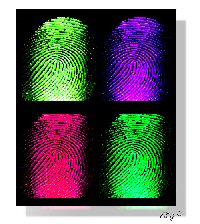Let’s do a little mini-roundup on the theme of science.
Let’s start with something that I want to see on CSI (and mean real CSI–not CSI:Orange Filter or CSI:Blue Filter):
Researchers develop fingerprint detection technology

…
MXRF actually detects the sodium, potassium and chlorine elements present in those salts, as well as many other elements, if they are present. The elements are detected as a function of their location on a surface, making it possible to “see” a fingerprint where the salts have been deposited in the patterns of fingerprints, the lines called friction ridges by forensic scientists.
The technique has several advantages over traditional fingerprint detection methods that involve treating the suspect area with powders, liquids, or vapors in order to add color to the fingerprint so that it can be easily seen and photographed. Using this technique, known as contrast enhancement, it is sometimes difficult to detect fingerprints present on certain substances, such as multicolored backgrounds, fibrous papers and textiles, wood, leather, plastic, adhesives and human skin. Children’s fingerprints are particularly difficult to detect due to the absence of sebum, an oily substance on the skin that is secreted by the sebaceous glands, which captures the contrast enhancing agents. Also, coloring a fingerprint with traditional contrast enhancement methods can be an arduous process that sometimes yields only limited success.
…more in link…
Second item: how did I miss the fact that NASA is running a podcast of science news? (Here’s the feed:  )
)
The idea of getting cool science content beamed directly to me from NASA is pretty nifty. Of course, you can also pick up a podcast of Quirks ‘n’ Quarks, but for some reason that show has never really clicked for me.
Finally, lets end up with a pointer to a real cool New Scientist article that outlines “13 things that do not make sense” in current science. Even more fun than reading about the bizarre things we currently understand (or at least have useful models for) is reading about the things we can observe, but which do not line up with any of our models…
New Scientist: 13 things that do not make sense
…
10 The Kuiper cliff
IF YOU travel out to the far edge of the solar system, into the frigid wastes beyond Pluto, you’ll see something strange. Suddenly, after passing through the Kuiper belt, a region of space teeming with icy rocks, there’s nothing.
Astronomers call this boundary the Kuiper cliff, because the density of space rocks drops off so steeply. What caused it? The only answer seems to be a 10th planet. We’re not talking about Quaoar or Sedna: this is a massive object, as big as Earth or Mars, that has swept the area clean of debris.
…more in link…

